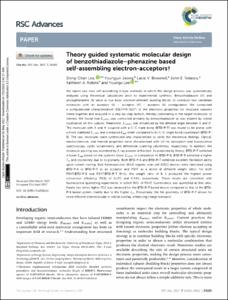Department of Energy Science and Engineering
Organic & Printed Electronics Laboratory(OPEL)
1. Journal Articles
Full metadata record
| DC Field | Value | Language |
|---|---|---|
| dc.contributor.author | Lee, Dong-Chan | - |
| dc.contributor.author | Jeong, Youngjun | - |
| dc.contributor.author | Brownell, Lacie V. | - |
| dc.contributor.author | Velasco, John E. | - |
| dc.contributor.author | Robins, Kathleen A. | - |
| dc.contributor.author | Lee, Youngu | - |
| dc.date.available | 2017-08-10T08:18:35Z | - |
| dc.date.created | 2017-08-09 | - |
| dc.date.issued | 2017 | - |
| dc.identifier.issn | 2046-2069 | - |
| dc.identifier.uri | http://hdl.handle.net/20.500.11750/4256 | - |
| dc.description.abstract | We report two new self-assembling n-type materials in which the design process was systematically analyzed using theoretical calculations prior to experimental synthesis. Benzothiadiazole (A′) and alkoxyphenazine (A) serve as our basic electron-deficient building blocks to construct two candidate molecules with an acceptor (A)-acceptor (A′)-acceptor (A) configuration. We conducted a computational characterization (B3LYP/6-31G∗) of the electronic properties for structural subunits linked together and analyzed in a step-by-step fashion, thereby culminating in the target molecules of interest. We found that ELUMO was controlled primarily by benzothiadiazole as was evident by orbital localization on this subunit. Meanwhile, EHOMO was influenced by the dihedral angle between A and A′. The molecule with A and A′ coupled with a C-C triple bond (BTD-P-T) was found to be planar with a more stabilized ELUMO and a reduced Egap when compared to its C-C single bond counterpart (BTD-P-S). The two molecules were synthesized and characterized to verify the theoretical findings. Optical, electrochemical, and thermal properties were characterized with UV-vis absorption and fluorescence spectroscopy, cyclic voltammetry, and differential scanning calorimetry, respectively. In addition, the molecular packing was examined by X-ray powder diffraction. As predicted by theory, BTD-P-T exhibited a lower Egap based on the system's lower ELUMO in comparison to BTD-P-S. BTD-P-T exhibited a higher Tm and crystallinity due to its planarity. Both BTD-P-S and BTD-P-T exhibited excellent fibrillation ability upon solvent casting. Bulk heterojunction (BHJ) organic solar cell (OSC) devices were fabricated using BTD-P-S or BTD-P-T as an acceptor and P3HT as a donor at different weight ratios. For both P3HT:BTD-P-S and P3HT:BTD-P-T BHJs, the weight ratio of 6:1 produced the highest power conversion efficiency (PCE) of 0.17% and 0.44%, respectively. These results are consistent with fluorescence quenching experiments in which 90% of P3HT fluorescence was quenched at that ratio. Nearly two times higher PCE was observed for the BTD-P-T based device compared to that of the BTD-P-S based system, mainly due to the higher Jsc. Presumably, the flat geometry of BTD-P-T allows for more efficient intermolecular π-orbital overlap, enhancing charge transport. © The Royal Society of Chemistry 2017. | - |
| dc.publisher | Royal Society of Chemistry | - |
| dc.title | Theory guided systematic molecular design of benzothiadiazole-phenazine based self-assembling electron-acceptors | - |
| dc.type | Article | - |
| dc.identifier.doi | 10.1039/c7ra03612d | - |
| dc.identifier.scopusid | 2-s2.0-85021719725 | - |
| dc.identifier.bibliographicCitation | RSC Advances, v.7, no.39, pp.24105 - 24112 | - |
| dc.description.isOpenAccess | FALSE | - |
| dc.subject.keywordPlus | Benzothiadiazoles | - |
| dc.subject.keywordPlus | Bulk Heterojunction (BHJ) | - |
| dc.subject.keywordPlus | Chemistrycomputation Theory | - |
| dc.subject.keywordPlus | Complexes | - |
| dc.subject.keywordPlus | Cyclic Voltammetry | - |
| dc.subject.keywordPlus | Design | - |
| dc.subject.keywordPlus | Differential Scanning Calorimetry | - |
| dc.subject.keywordPlus | Dihedral Angle | - |
| dc.subject.keywordPlus | Efficiency | - |
| dc.subject.keywordPlus | Electron Deficient | - |
| dc.subject.keywordPlus | Electronic Properties | - |
| dc.subject.keywordPlus | Fluorescence | - |
| dc.subject.keywordPlus | Fluorescence Quenching | - |
| dc.subject.keywordPlus | Fluorescence Spectroscopy | - |
| dc.subject.keywordPlus | Heterojunctions | - |
| dc.subject.keywordPlus | Molecular Packings | - |
| dc.subject.keywordPlus | Molecules | - |
| dc.subject.keywordPlus | Optical Properties | - |
| dc.subject.keywordPlus | Organic Photovoltaics (OPV) | - |
| dc.subject.keywordPlus | Organic Solar Cells | - |
| dc.subject.keywordPlus | PI Conjugated Systems | - |
| dc.subject.keywordPlus | Polymer Solar Cells (PSCs) | - |
| dc.subject.keywordPlus | Power Conversion Efficiencies | - |
| dc.subject.keywordPlus | Pyrazine Acenes | - |
| dc.subject.keywordPlus | Quenching | - |
| dc.subject.keywordPlus | Rational Design | - |
| dc.subject.keywordPlus | Semiconductors | - |
| dc.subject.keywordPlus | Solar Cells | - |
| dc.subject.keywordPlus | Synthesis (Chemical) | - |
| dc.subject.keywordPlus | Theoretical Calculations | - |
| dc.subject.keywordPlus | UV Visible Absorptions | - |
| dc.subject.keywordPlus | X Ray Powder Diffraction | - |
| dc.citation.endPage | 24112 | - |
| dc.citation.number | 39 | - |
| dc.citation.startPage | 24105 | - |
| dc.citation.title | RSC Advances | - |
| dc.citation.volume | 7 | - |
- Files in This Item:
-
 기타 데이터 / 1 MB / Adobe PDF
download
기타 데이터 / 1 MB / Adobe PDF
download



